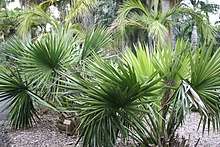Sabal minor
Sabal minor, commonly known as the dwarf palmetto,[2] is a small species of palm. It is native to the deep southeastern and south-central United States and northeastern Mexico. It is naturally found in a diversity of habitats, including maritime forests, swamps, floodplains, and occasionally on drier sites.[3] It is often found growing in calcareous marl soil.[4] Sabal minor is one of the most frost and cold tolerant among North American palms.
| Sabal minor | |
|---|---|
 | |
| Scientific classification | |
| Kingdom: | Plantae |
| Clade: | Tracheophytes |
| Clade: | Angiosperms |
| Clade: | Monocots |
| Clade: | Commelinids |
| Order: | Arecales |
| Family: | Arecaceae |
| Genus: | Sabal |
| Species: | S. minor |
| Binomial name | |
| Sabal minor (Jacq.) Pers. | |
| Synonyms[1] | |
|
Synonymy
| |
Distribution
This palm's native range spans on the Atlantic Coast from central Florida north to Monkey Island, North Carolina.[4] On the Gulf Coast, it spans from central Florida to central Texas, Arkansas, north to southern Oklahoma, then south in the State of Nuevo León in Mexico.[1]
Description
The dwarf palmetto grows up to 1 m (rarely 3 m) in height, with a trunk up to 30 centimetres (12 in) diameter. It is a fan palm (Arecaceae tribe Corypheae), with the leaves with a bare petiole terminating in a rounded fan of numerous leaflets. Each leaf is 1.5–2 metres (4 ft 11 in–6 ft 7 in) long, with 40 leaflets up to 80 centimetres (31 in) long, conjoined over half of this length. The flowers are yellowish-white, 5 millimetres (0.20 in) across, produced in large compound panicles up to 2 metres (6 ft 7 in) long, extending out beyond the leaves. The fruit is a black drupe 1 to 1.3 centimetres (0.39 to 0.51 in) long containing a single seed.[3]
Cultivation
Sabal minor is one of the most cold hardy palms in cultivation. It does best however, when grown in hot and humid tropical summer conditions, and may struggle or grow slowly in cool summer climates. It is leaf hardy to near 0 °F (−18 °C), and has been known to survive brief periods of −5 °F (−21 °C) temperatures. It is generally cultivated in subtropical and warm temperate climates. Sabal minor can grow in a wide variety of soil types, and is often found submerged in swamps in the subtropical southeastern United States. It grows in both full sun and shaded locations, though it will do best in the cooler garden zones (below zone USDA 7) in full sun and a wind sheltered location.
In the United States, since the 1960s, cultivation of sabal minor has spread beyond the deep southern United States. Sabal minor is cultivated along the East Coast from Florida to coastal Connecticut, and on the West Coast from Vancouver BC south to San Diego. It is a recommended horticultural plant by the Virginia Cooperative Extension.[5] There are several cultivars, including those from the Outer Banks of North Carolina (northernmost strains), and those from Oklahoma and Texas. One popular strain is 'McCurtain', named after McCurtain County, Oklahoma, where they are native. These tend to remain trunkless and smaller than those from warmer areas. Sabal minor is a popular landscape palm in coastal resort areas from Virginia Beach, Virginia, to southern Texas.
Gallery
 Young Sabal minor
Young Sabal minor A naturalistic planting of Sabal minor outside the National Air and Space Museum in Washington, DC.
A naturalistic planting of Sabal minor outside the National Air and Space Museum in Washington, DC. Sabal minor - MHNT
Sabal minor - MHNT
References
- Kew World Checklist of Selected Plant Families
- "Sabal minor". Natural Resources Conservation Service PLANTS Database. USDA. Retrieved 26 October 2015.
- Sabal minor in Flora of North America
- "Flora of the Southern and Mid-Atlantic States by Alan Weakley".
- Care Sheet for Sabal minor or “Dwarf Palmetto” in Virginia Landscapes Fact and Care Sheet for Virginia Gardens